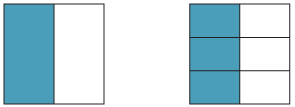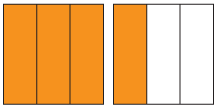![]()
Using squares
We can use squares to see that the area representing \(\dfrac{1}{2}\) equals the area representing \(\dfrac{3}{6}\).

Equivalent improper fractions
We can use squares to show that \(\dfrac{4}{3}\) is equivalent to \(\dfrac{20}{15}\). The area of each large square is 1.
Shaded area A represents the fraction \(\dfrac{4}{3}\) and shaded area B represents the fraction \(\dfrac{20}{15}\). The two areas are the same, so \(\dfrac{4}{3}\) is equivalent to \(\dfrac{20}{15}\).






